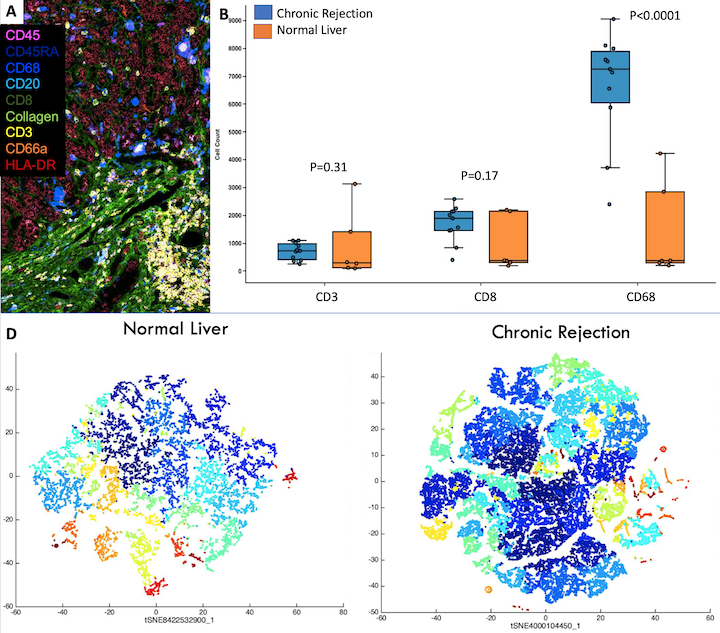Multiplexed Imaging Mass Cytometry Analysis Reveals a New Role for CD68+ Macrophages in Chronic Liver Transplant Rejection
J. Emamaullee, C. Man, J. Hoeflich, N. Ung, R. Sun, N. Matasci, J. Katz, J. Lee, S. Chopra, L. Sher, S. Asgharzadeh, O. Akbari, Y. Genyk
University of Southern California, Los Angeles, CA
Meeting: 2020 American Transplant Congress
Abstract number: 416
Keywords: Graft-infiltrating lymphocytes, Image analysis, Liver transplantation, Rejection
Session Information
Session Name: Biomarkers, Immune Assessment and Clinical Outcomes IV
Session Type: Oral Abstract Session
Date: Saturday, May 30, 2020
Session Time: 3:15pm-4:45pm
 Presentation Time: 4:15pm-4:27pm
Presentation Time: 4:15pm-4:27pm
Location: Virtual
*Purpose: Rejection continues to be an important cause of graft loss and failure post-liver transplant (LT). Recently, a novel high-resolution mass spectrometry-based technique has been developed called Imaging Mass Cytometry (IMC). In this study, we developed a liver-specific IMC panel as well as an informatics-based analysis pipeline to quantify which lymphocytes are involved in chronic rejection (CR) post-LT.
*Methods: A retrospective review of our LT program identified cases of re-transplant for CR. Regions of interest were identified by our clinical pathologist. A panel of heavy metal-tagged antibodies (Collagen, CD45RA, CD45, CD20, CD3, CD8, CD66a, CD68, CD235, HLA-DR) and a nuclear tag (Iridium) were used simultaneously on fixed tissue sections and analyzed using the Hyperion CyTOF System (Fluidigm). An IMC Analysis Pipeline was developed for segmentation and downstream quantification and analysis. A total of nine cases of CR and three normal liver sections have been studied thus far.
*Results: Histological analysis using IMC resulted in high resolution staining for each marker (representative case, Fig. 1A). Relatively few CD3+ or CD8+ effector T-cells were identified in CR tissue (Panel B). Surprisingly, there were significantly more CD68+ macrophages in CR tissue (p<0.001). A combination of PhenoGraph clustering and t-SNE analysis of CD3, CD8, CD68, CD45, CD66a, and CD20 revealed heterogeneous lymphocyte subsets in CR when compared to normal liver (Panel C). Spatial relationships via neighborhood analysis and clustering are ongoing.
*Conclusions: This study represents the first application of IMC in solid organ transplantation and highlights the power of this technique to provide high fidelity, quantitative information regarding lymphocyte subsets in human tissue sections to better understand allograft rejection. Hepatic macrophages have not typically been considered to be involved in CR post-LT, and these data suggest that they may represent a new important therapeutic target to treat CR. Further development of IMC has the potential to provide deep, multi-dimensional analyses into the histological basis of disease, particularly in small tissue biopsy specimens.
To cite this abstract in AMA style:
Emamaullee J, Man C, Hoeflich J, Ung N, Sun R, Matasci N, Katz J, Lee J, Chopra S, Sher L, Asgharzadeh S, Akbari O, Genyk Y. Multiplexed Imaging Mass Cytometry Analysis Reveals a New Role for CD68+ Macrophages in Chronic Liver Transplant Rejection [abstract]. Am J Transplant. 2020; 20 (suppl 3). https://atcmeetingabstracts.com/abstract/multiplexed-imaging-mass-cytometry-analysis-reveals-a-new-role-for-cd68-macrophages-in-chronic-liver-transplant-rejection/. Accessed December 21, 2025.« Back to 2020 American Transplant Congress

